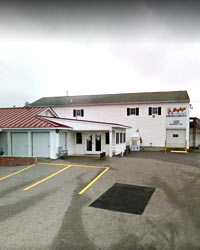Blue Lobsters
Feb 15th 2014
Quite a few of our commonly asked questions revolve around the phenomenon of the blue lobster. The picture I have posted here is of a blue lobster that we had in residence about fifteen years ago, Clawdon Blue (any comments will be forwarded to the smart guy who named him). He is on a cement floor next to a normal lobster of the same size. Both were live lobsters. Though I had to import this photo into Photoshop to post it, I can assure you that the colors are real. Plus, I am just not that good with Photshop.
Researchers have determined that lobsters have proteins in their shells which create red and blue colors. The normal mixing of these two proteins causes lobsters to be a mottled brownish black color, with every lobster having a slightly different hue. Occasionally, a genetic occurrence will cause an overabundance of the blue protein and the lobster will look like our friend Clawd. We have also had lobsters brought in by our fishermen that have an overabundance of the red protein and they looked like fully-cooked lobsters in the tank when they were live. When cooked, the blue lobsters still turn red, but it is a slightly lighter shade.
The rate of occurrence of blue lobsters has been quoted as anywhere from one in a million to one in two million. I would rate one in a million as fairly accurate considering the millions of lobsters that we have sold over the years and the number of blue lobsters that we have seen. We have also had yellow lobsters, lobsters with yellow and black spots and lobsters that are two colors, which split right down the center of the lobster. You never know what you are going to get out of that next trap!
If you are interested in reading more about the science behind blue lobster research, check out this site:
http://advance.uconn.edu/2005/050328/05032810.htm
Get the full story here:



